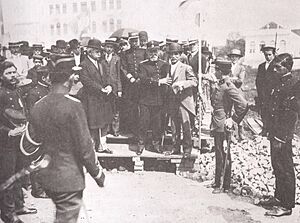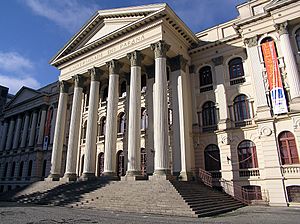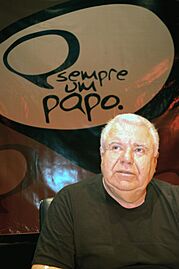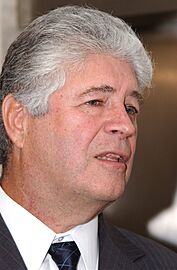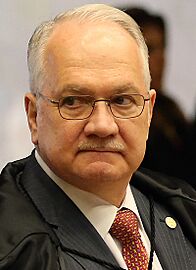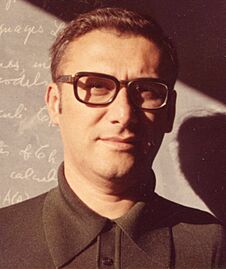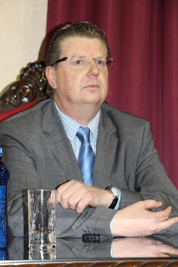Federal University of Paraná facts for kids
|
Universidade Federal do Paraná
|
|
 |
|
|
Other names
|
UFPR |
|---|---|
|
Former names
|
Universidade do Paraná |
| Motto | Scientia et Labor |
|
Motto in English
|
Science and Work |
| Type | Public (federal) |
| Established | 1912 |
| Budget | R$ 1,038,070,033.68 (2013) |
| Rector | Ricardo Marcelo Fonseca |
|
Academic staff
|
2,328 |
|
Administrative staff
|
3,759 |
| Undergraduates | 28,048 |
| Postgraduates | 8,658 |
| Location |
,
Brazil
|
| Campus | Curitiba, Matinhos, Palotina, Pontal do Paraná and Jandaia do Sul |
The Federal University of Paraná (UFPR) is a big public university in Curitiba, Brazil. It's one of the oldest universities in the country.
UFPR is known as one of the best universities in Latin America. It is also ranked among the top universities in the world. In Brazil, it is often listed as one of the top ten universities.
Today, UFPR has campuses in Curitiba and other cities in the state of Paraná. It offers many different courses for students. These include over 120 undergraduate degrees. It also has many master's and doctorate programs.
Contents
History of UFPR
The idea for the university started in 1892. A smart person named José Francisco da Rocha Pombo wanted to build it. But his plan was stopped by a political movement.
Twenty years later, Paraná was growing fast. This was thanks to the production of yerba mate. There were not many highly educated people in the state yet.
Around this time, the Contestado War was happening. This encouraged leaders to create a university. Victor Ferreira do Amaral, a local leader, began the real work to start the university.
On December 19, 1912, the university was officially created. It opened its doors in 1913 as a private school. It was in an old building on Comendador Araújo street. The first courses taught were Law, Engineering, Medicine, Commerce, Dentistry, Pharmacy, and Obstetrics. Victor Ferreira do Amaral became its first president. He started building a main building on land given by the city.
The First World War caused money problems. In 1920, a law tried to close all universities. But the government also created a new university in Rio de Janeiro. To keep UFPR open, it was split into several separate colleges.
For many years, people worked to bring the university back together. In the early 1950s, the colleges were finally reunited. In 1951, the university became a public institution. This meant it was free for students to attend.
After becoming a public university, UFPR grew a lot. The Clinic's Hospital was built in 1953. The Reitoria Campus opened in 1958. The Polytechnic Center was built in 1961. This center covers a very large area.
UFPR's Historic Building
Work on the main building in Santos Andrade Square began in 1913. It was designed by engineer Baeta de Faria. The building was first opened in 1915.
In 1923, two side parts were added to the building. The right side was finished in 1925 for Engineering students. The left side was done in 1926 for Dentistry students. More additions were made, and the building was repainted in 1940. It was also made longer towards XV de Novembro Street. In 1952, part of the building's side was changed again.
By 1954, the building took up a whole city block. The final changes included new columns and large staircases. The covered dome on top was removed. The new, large building was officially opened in 1955.
In 1999, the mayor of Curitiba made this building an official symbol of the city.
What You Can Study at UFPR
Undergraduate Programs
UFPR offers many different bachelor's degree programs. Here are some of them:
- Accounting
- Agriculture Engineering
- Agronomy
- Architecture and Urbanism
- Biology
- Biomedicine
- Business Administration
- Chemical Engineering
- Chemistry
- Civil Engineering
- Computer Science
- Dentistry
- Economics
- Electrical Engineering
- Environmental Engineering
- Food Engineering
- Forestry Engineering
- Geography
- History
- Law
- Mathematics
- Mechanical Engineering
- Medicine
- Music
- Nursing
- Nutrition
- Pharmacy
- Philosophy
- Physical Education
- Physics
- Psychology
- Social Sciences
- Tourism
- Veterinary Medicine
- Visual Arts
Master Programs
After a bachelor's degree, students can study for a master's degree. Some of these programs include:
- Physical Education
- Pharmacology
- Biochemistry
- Genetics
- Zoology
- Botany
- Child and Teenager Health
- Pharmaceutical Sciences
- Surgery
- Nursing
- Geology
- Geography
- Environmental Development
- Applied Mathematics
- Information Systems
- Chemistry
- Physics
- Education
- Anthropology
- Sociology
- History
- Philosophy
- Psychology
- Languages and Literature
- Design
- Music
- Business Administration
- Accounting and Finance
- Law
- Electrical Engineering
- Civil Engineering
- Mechanical Engineering
- Chemical Engineering
- Political Sciences
Doctoral Programs
For those who want to study even more, UFPR has doctoral programs. These are some of the areas:
- Agronomy
- Anthropology
- Forestry Engineering
- Computer Science
- Entomology
- Cell Biology
- Pharmacology
- Biochemistry
- Genetics
- Zoology
- Child and Teenager Health
- Surgery
- Internal Medicine and Health Sciences
- Geology
- Geography
- Environmental Development
- Mechanical Engineering
- Chemistry
- Physics
- Education
- Sociology
- History
- Languages and Literature
- Business Administration
- Law
- Veterinary Medicine
- Microbiology
- Philosophy
Technical High School
UFPR also has a Technical High School. This school offers high school education.
How to Get In
To get into UFPR, students take an entrance exam called the vestibular. It has two main parts:
- Part I has 90 multiple-choice questions. These questions cover subjects like Portuguese, Literature, Chemistry, Mathematics, Physics, Geography, History, and Biology. There are also eight questions in a foreign language. Students can choose from English, French, Spanish, German, or Italian.
Many thousands of students take this first part of the exam each year. After about two weeks, some students are invited to take Part II.
- Part II is a written exam. It includes a Portuguese test with five writing essays. Some courses also require extra exams. These might be open-ended questions in Chemistry, Mathematics, Physics, Geography, History, Biology, Philosophy, or Sociology. The specific exams depend on the course a student wants to study. For example, students applying for Engineering take Math and Physics tests.
Waiting for the results of Part II takes longer, usually 4 to 7 weeks. The list of accepted students usually comes out in mid-January. On that day, there's a fun "Mud-bath Party" organized by the student group.
Laboratories at UFPR
UFPR has many laboratories where students and researchers can learn and discover new things. Here are a few examples:
- Centro de Documentação e Pesquisa de História dos Domínios Portugueses (CEDOPE)
- Centro de Ciência de Segurança Computacional (CCSC)
- Centro de Computação Científica e Software Livre (C3SL)
- Centro de Estudos do Mar (CEM)
- Centro de Microscopia Eletrônica (CME)
- Centro de Pesquisa e Processamento de Alimentos (CEPPA)
- Grupo IMAGO de Pesquisa em Visão Computacional
- Instituto de Tecnologia para o Desenvolvimento (LACTEC)
- Laboratório de Análises Clínicas Veterinárias
- Laboratório de Eletroquímica de Superfícies e Corrosão (LESC)
- Laboratório de Estudos em Monitoramento e Modelagem Ambiental (LEMMA)
- Laboratório de Ictiologia Estuarina
- Laboratório de Inventário Florestal
- Laboratório de Minerais e Rochas (LAMIR)
- Laboratório de Nutrição Animal
- Laboratório de Parasitologia Clínica Veterinária (LPCV)
- Laboratório de Pesquisas Hidrogeológicas (LPH)
- Laboratório de Proteção Florestal
- Laboratório de Neurobiologia
- Laboratório de Citogenética Humana
- Laboratório de Genética Molecular Humana (LGMH)
- Laboratório de Óptica de Raios-X e Instrumentação (LORXI)
- Laboratório de Superfícies e Interfaces (LSI)
- Laboratório de Genética de Microorganismos (LabGeM)
- Núcleo de Redes sem Fio e Redes Avançadas (NR2)
And many more specialized labs!
Libraries at UFPR
The university has a huge collection of books and research papers. There are over 400,000 books and thousands of magazines. These are spread across different libraries:
- Juvevê Campus: For Agricultural Science.
- Centro Campus: Includes the main administrative library, Human and Educational Science, Health Science (main), and Judicial Science.
- Centro Politécnico Campus: For Science and Technology, Biological Science, and the Technical High School.
- Jardim Botânico Campus: For Forest and Wood Sciences, Health Science (secondary), Applied Social Sciences, and Physical Education.
- Matinhos Campus: UFPR Litoral.
- Paranaguá Campus: Archeology and Ethnology Museum of UFPR.
- Pontal do Paraná Campus: Sea Studies Center.
UFPR Campuses
UFPR has several campuses where students attend classes and do research.
- In Curitiba
- Campus Juvevê
- Campus Batel
- Campus Centro
- Campus Reitoria
- Campus Ciências Agrárias/Cabral
- Campus III/Centro Politécnico
- Campus III/Escola Técnica
- Campus III/Jardim Botânico
- Other cities in Paraná
- Campus Palotina – in Palotina
- Campus Estudos do Mar – in Pontal do Paraná
- Campus Litoral – in Matinhos
- Campus Jandaia do Sul – in Jandaia do Sul
Famous People Who Studied at UFPR
Many successful people have studied at the Federal University of Paraná. Here are a few:
- Blairo Maggi — a successful business person in agriculture.
- Clèmerson Merlin Clève — a lawyer and business person.
- Dalton Trevisan — a famous writer.
- Edson Fachin — a judge and lawyer.
- Enedina Alves Marques — the first Black woman in Brazil to become a civil engineer.
- Jaime Lerner — a former governor of Paraná.
- Laurentino Gomes — a writer and journalist.
- Newton da Costa — a logician and mathematician.
- Roberto Requião — a former governor and senator of Paraná.
- Tirone E. David — a medical doctor.
- Notable UFPR Alumni
See also
 In Spanish: Universidad Federal de Paraná para niños
In Spanish: Universidad Federal de Paraná para niños
- Brazil University Rankings
- List of federal universities of Brazil
- Universities and Higher Education in Brazil


